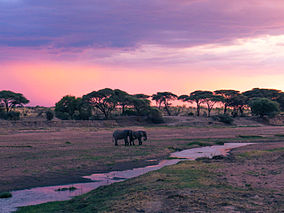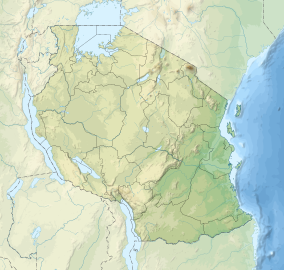Ruaha National Park
| Ruaha National Park | |
|---|---|
|
IUCN category II (national park)
|
|
 |
|
| Location | Tanzania |
| Nearest city | Iringa |
| Coordinates | 7°30′S 35°00′E / 7.500°S 35.000°ECoordinates: 7°30′S 35°00′E / 7.500°S 35.000°E |
| Area | 20,226 km2 (7,809 sq mi) |
| Established | 1964 |
| Visitors | 21,267 (in 2012) |
| Governing body | Tanzania National Parks Authority |
Ruaha National Park is the largest national park in Tanzania. The addition of the Usangu Game Reserve and other important wetlands to the park in 2008 increased its size to about 20,226 square kilometres (7,809 sq mi), making it the largest park in Tanzania and East Africa.
The park is about 130 kilometres (81 mi) west of Iringa. The park is a part of the 45,000 square kilometres (17,000 sq mi) Rungwa-Kizigo-Muhesi ecosystem, which includes the Rungwa Game Reserve, the Kizigo and Muhesi Game Reserves, and the Mbomipa Wildlife Management Area.
The name of the park is derived from the Great Ruaha River, which flows along its southeastern margin and is the focus for game-viewing. The park can be reached by car on a dirt road from Iringa and there are two airstrips – Msembe airstrip at Msembe (park headquarters), and Jongomeru Airstrip, near the Jongomeru Ranger Post.
Germany gazetted the Saba Game Reserve in 1910.British colonial authorities changed the name to the Rungwa Game Reserve in 1946. In 1964, the southern portion of the reserve was excised and elevated to full park status.
The park formerly was known for its large elephant population, numbering 34,000 in the Ruaha-Rungwa ecosystem in 2009 but only 15,836 (plus or minus 4,759) in 2015.
More than 571 species of birds have been identified in the park. Among the resident species are hornbills. Many migratory birds visit the park.
Other noted animals found in this park are cheetah, African leopard, lion (Africa's second largest population, representing 10 percent of the world population), African wild dog (third largest population in the world), spotted hyena, giraffe, hippopotamus, African buffalo, and sable antelope. The best times to visit for predators and large mammals is during the dry season (May–December) and for birds and flowers, during the wet season (January–April).
...
Wikipedia

